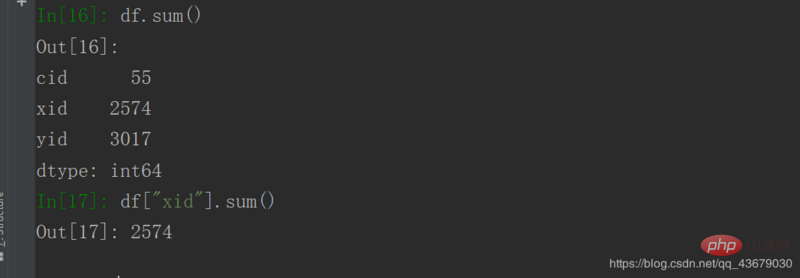本篇文章给大家带来的内容是关于Python中简单统计量的计算,有一定的参考价值,有需要的朋友可以参考一下,希望对你有所帮助。
1、这些操作都要确保已经在电脑中安装好了Anaconda集成库,如果安装好后运行出错误,可以将原来电脑中的python卸载重新安装Anaconda,建议安装时直接将添加环境变量打勾,否则以后得自己添加环境变量,在Pycharm中的编译器选择Anaconda安装文件夹中的python。在Pycharm中新建一个data文件夹用来存放数据文件。

2.打开Python Console。
3.首先在用python读取数据,需要先输入import pandas as pd引入pandas包,再输入df=pd.read_csv("./data/CityData.csv")读取数据,最后输入df显示数据。

4.分别输入type(df)和type(df["cid"])可以发现两种数据类型不同。


5.计算平均值:df.mean()或df["xid"].mean()

6.计算中位数:输入df.median()或df["yid"].median

7.求四分位数:输入df.quantile(q=0.25)

8.求众数:输入df.mode()或df["xid"].mode()
9.求标准差:输入df.std()或df["yid"].std()

10.计算方差:df.var()或df["xid"].var()

11.求和:df.sum()或df["xid"].sum()

12.计算偏态系数:df.skew()或df["yid"].skew()

13.计算峰态系数:df.kurt()或df["yid"].kurt()

14.生成正态分布函数,pandas无法直接生成,需要先引入scipyimport scipy.stats as ss,再输入ss.norm,这时生成的是一个正态分布的对象,我们输入ss.norm.stats(moments="mvsk")查看一下,mvsk分别代表的是均值、方差、偏态系数、峰态系数。

这时我们可以看到生成四个值,分别对应正态分布的mvsk分别为0、1、0、0。
15.ss.norm.pdf(0.0)表示横坐标为0时的纵坐标的值。ss.norm.ppf(0.9)表示从负无穷累积到返回值时得到的值为0.9,其中ppf后的值必须在0-1之间。ss.norm.cdf(2)表示从负无穷积分到2时的返回值,ss.norm.rvs(size=10)可以得到10个随机的符合正态分布的数字。

16.类似的,我们可以分别输入ss.chi2和ss.t得到卡方分布和T分布。

17.此外我们还可以进行抽样,输入df.sample(n=10)从数据中抽取10个样本,输入df.sample(frac=0.1)从数据中抽取10%的样本。

以上就是Python中简单统计量的计算的详细内容,更多请关注php中文网其它相关文章!




Copyright 2014-2023 //m.sbmmt.com/ All Rights Reserved | 苏州跃动光标网络科技有限公司 | 苏ICP备2020058653号-1
| 本站CDN由 数掘科技 提供